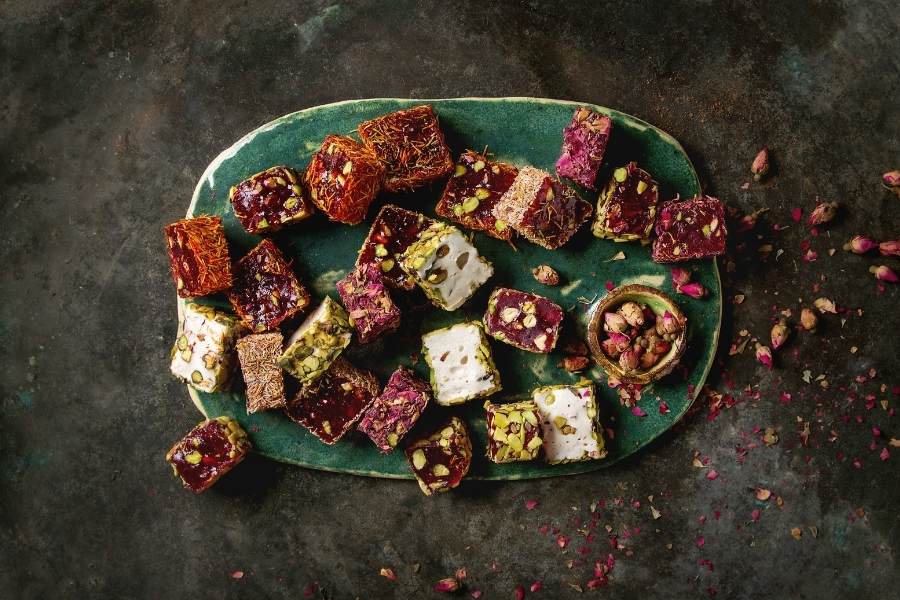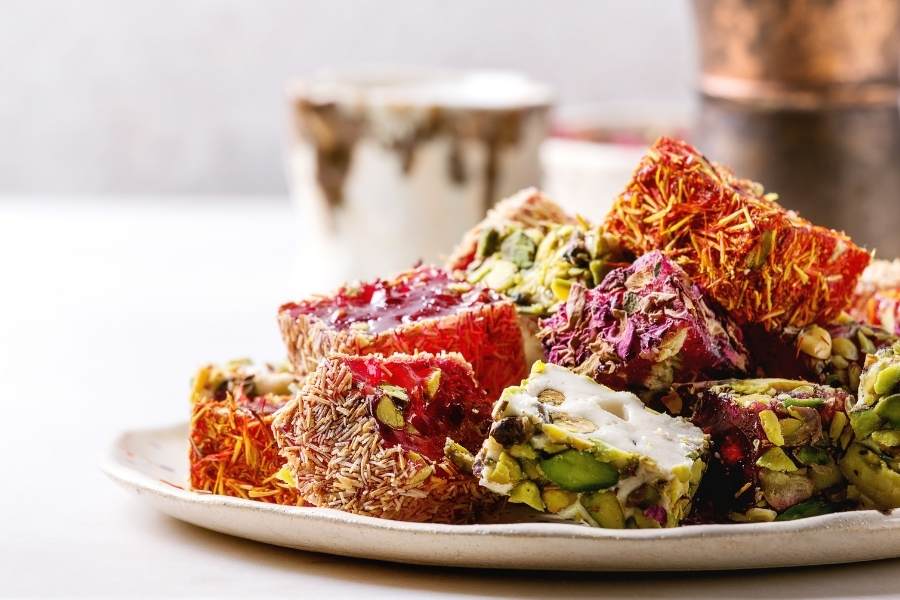In the vibrant culinary tapestry of Turkey, one sweet delicacy stands out with its rich history and colorful presentation – the Turkish Delight. Known as ‘Lokum’ in Turkish, this sweet treat has been a cherished part of Turkish culture for centuries. As we delve into the sugary world of Turkish Delight, we also step back in time, savoring a piece of Ottoman heritage.
The creation of Turkish Delight is not merely a culinary venture but an art form, handed down through generations since the Ottoman era. The process begins with a mixture of sugar, starch, and water, boiled together to form a sticky, gel-like substance. As the mixture cools, a delicate dance of flavors begins, with the infusion of natural essences like rosewater, lemon, or pomegranate. The final touch is a dusting of icing sugar and desiccated coconut, creating a sweet treat that is as pleasing to the eye as it is to the palate. Each bite of Turkish Delight is a tribute to the meticulous craftsmanship of the confectioners of yore, offering a sweet glimpse into Turkey’s rich culinary past.
Historical Roots of Turkish Delight
The origins of Turkish Delight date back to the 15th century during the Ottoman Empire’s reign. It’s believed that the confectionery was crafted to please the sultans and their courts. Over time, it became a significant part of the Turkish culinary tradition, entwining itself with the cultural and social fabric of the region.
The story goes that in his endeavor to win the hearts of his numerous wives, a certain sultan ordered his confectioner to create a unique sweet treat. The result was the delicate cubes of Lokum we now know as Turkish Delight. This novel creation quickly found favor in the royal court, becoming a coveted indulgence among the nobility.
As the reputation of Turkish Delight grew, it started to play a role in Turkish social traditions. It became customary to offer a piece of Turkish Delight as a gesture of hospitality and goodwill during gatherings and celebrations. This sweet gesture was a symbol of warmth and friendship, embodying the spirit of camaraderie that is intrinsic to Turkish culture.
Moreover, the art of making Turkish Delight was honed over centuries, with families passing down secret recipes and techniques through generations. The mastery involved in crafting the perfect cube of Lokum is a reflection of the deep-rooted culinary expertise that has been a hallmark of Turkish culture. Through the ups and downs of history, Turkish Delight has remained a steadfast emblem of Turkish hospitality and culinary heritage.
Turkish Delight Through the Ages
As centuries rolled by, the popularity of Turkish Delight transcended the borders of the Ottoman Empire, finding its way into the hearts and homes of people across Europe and beyond. The meticulously crafted sweet treat became synonymous with Turkish hospitality and the exquisite finesse of Ottoman cuisine.
Varieties and Flavors of Turkish Delight
The allure of Turkish Delight lies in its myriad flavors and textures. From the classic rose flavor to exotic pomegranate, and from the soft, gel-like consistency to the ones filled with nuts, the variety is endless. Each type of Turkish Delight carries with it a unique taste and a snippet of Turkish history.
The tradition of Turkish Delight crafting has led to an extensive array of flavors and textures that cater to diverse palates. Each flavor and texture narrate a tale of regional ingredients and age-old recipes.

Classic Rose Flavor
The rose flavored Turkish Delight is perhaps the most traditional and beloved variety. The infusion of rosewater imparts a delicate floral essence that transports one to the rose gardens of Isparta, a region in Turkey famous for its roses.
Exotic Pomegranate and Other Fruits
The tantalizing taste of pomegranate in Turkish Delight is a newer yet well-embraced flavor. Alongside pomegranate, a multitude of other fruit flavors like lemon, orange, and strawberry, showcase the bountiful produce of Turkey’s fertile lands.
Nut-filled Delights
For those who crave a crunch, Turkish Delight filled with pistachios, hazelnuts, or walnuts provide a delightful texture contrast to the soft, jelly-like consistency of the candy. The inclusion of nuts is not just about the texture, but also a nod to the region’s rich nut-producing heritage.
Herb and Spice Infused Varieties
Over the centuries, adventurous confectioners have also experimented with infusing Turkish Delight with herbs and spices like cinnamon and clove, adding a warm, spicy kick to the sweet treat.
Powdered Varieties
Some Turkish Delight varieties come dusted in a coating of icing sugar or desiccated coconut, adding another level of texture and flavor. This powdered exterior creates a delightful contrast to the smooth, chewy interior, making each bite a multifaceted taste experience.
Each of these varieties not only provides a different taste experience but also serves as a testament to the creativity and rich culinary traditions of Turkey. Through the lens of Turkish Delight, one can explore the beautiful diversity and the time-honored food culture of this enchanting land.
Experiencing Turkish Delight at Deraliye Restaurant
At Deraliye Restaurant, we honor the time-honored tradition of Turkish Delight by offering our guests a taste of this historic sweet treat. Nestled in the heart of Sultanahmet, our restaurant provides a perfect setting to explore the diverse flavors of Turkish Delight, alongside a menu steeped in Ottoman culinary tradition.
The saga of Turkish Delight is not merely a tale of a sweet confection, but a narrative of Turkey’s rich culinary and cultural heritage. Whether enjoyed as a delightful ending to a meal at Deraliye Restaurant or as a sweet souvenir of your Turkish adventure, Turkish Delight remains a beautiful symbol of Turkish hospitality and a sweet bridge to its illustrious past.








